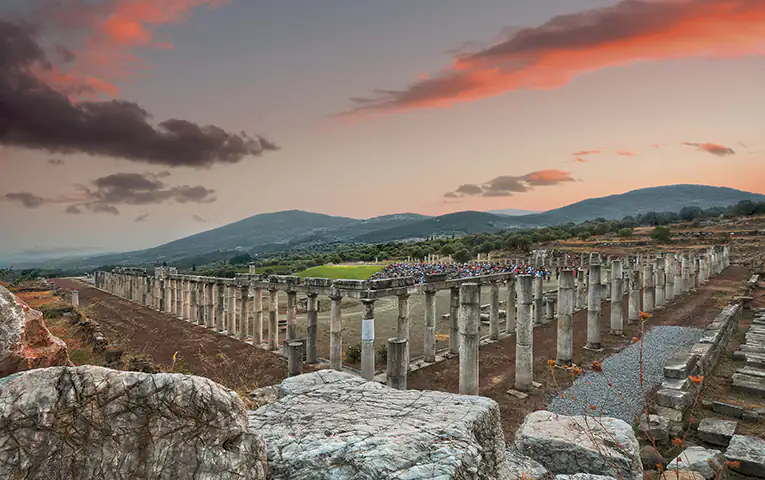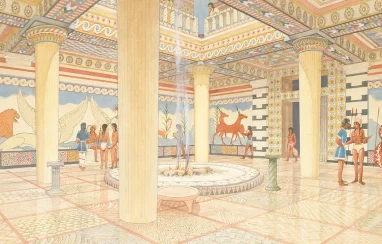By Tassoula Eptakili
Our tale begins in 371 B.C., the year the Thebans, led by their general Epaminondas, defeated the Spartans at Leuctra in Boeotia. Sparta capitulated and withdrew its army. Its dominance had ended. In the Peloponnese, the news gave Messenians cause to celebrate, as it signaled their liberation from the Laconian yoke after more than three centuries. The exiles returned as free men and citizens of an independent nationstate, free to determine their own destiny.
In 369 B.C., they established a new capital, which was built using pioneering town-planning and fortification techniques. They wanted a grandiose city that would make their presence felt and shape their new political identity and sense of nation. So, Messene was born from the fertile earth of Messinia, getting its name from the first mythical queen of the region, King Triopas of Argos’ daughter and wife of Polycaon from Laconia.
Democracy and egalitarianism
Ancient Messene was larger than Athens at the time, covering an expanse of 290 hectares. It had formidable fortification walls that were 9.5 kilometers in length and imposing public buildings and temples. Most impressive among them was the complex comprising the Gymnasium and Stadium, which had a length of 200 meters, as well as the Theater, which could seat 12,000 spectators and was equipped with a mobile stage for hosting cultural and political events. Every aspect of the architecture was designed to express beliefs about democracy, equality before the law (isonomia) and equal property rights (isomeria). The city was built in a way that ensured the equal distribution of land between rich and poor, while everyone could access its majestic center, comprising the 4-hectare Agora, as well as all of its public buildings and religious monuments.
In the 3rd and 2nd centuries B.C., and later, during the Roman conquest, Messene enjoyed the privilege of self-rule, with the Pax Romana ensuring it a long period of economic and cultural prosperity. Its residents had a comfortable lifestyle, with funds coming from a vibrant agricultural and livestock production sector, as well as from trade with Italy, Crete and Egypt. The more money that came in, the more brilliant its temples became with valuable offerings and ornate mosaics.
“All the findings point to the fact that Messene was an outlying region in the ancient Greek world that began to grow as the other big centers began to decline,” says Professor Emeritus of Archaeology Petros Themelis, who is leading the excavation project at the site.
Messene, however, was also doomed to fall and by the 3rd century A.D. it had been completely abandoned. Its buildings collapsed over time and in the centuries that followed the residents of the area used the marble statues to produce lime, tore out building materials from its structures to use on their homes and churches, dismantled the steps of the theater and removed all precious metals.

New life for an ancient city-state
Ancient Messene was gone and nearly forgotten. Even though excavations at the site had started in 1895 under Themistocles Sophoulis, an architect from the island of Samos and later prime minister of Greece, by 1986 it was still just an expanse with scattered ruins that was crossed by a rural road and was mostly covered by olive groves, vineyards and grazing land. In 1986, however, the board of the Archaeological Society assigned the excavations to Professor Themelis, the visionary archaeologist who has dedicated his life to breathing new life into the forgotten city-state. Since that day, he and his associates have continued to unearth new parts of the city, revealing it in all its splendor.
The excavation and restoration project has transformed Ancient Messene into a model archaeological site that allows visitors to explore an entire ancient city that has been wonderfully preserved over the passage of time and whose main features are still standing: strong fortification walls, monumental gates, the Asclepieion, the Ekklesiasterion, its Doric temple, the Gymnasium, the Stadium, the Theater, the Sanctuary of Demeter and the Dioscouroi, the Agora and the famed Arsinoe Fountain (which according to Pausanias was named after the daughter of the mythical king of Messene Leucippus and mother of the god Asclepius).
[Edited version of an article published in Costa Navarino Stories, Issue 03]

